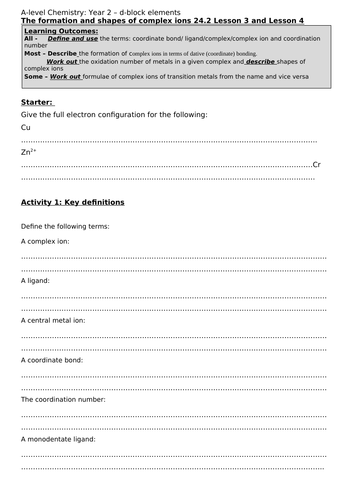


Student workbook and teacher PP for OCR A Level Chemistry A Year 2 Unit 24 Transition elements, Chapter 24.2 Formation and shape of complex ions, which could be used over two lessons. The following being covered:
Formation of complex ions with bidentate and monodentate ligands (including writing formulae and deducing the charges ). Naming positive and negative complexes is covered ( as a stretch and challenge).
Shapes of complex ions-square planar, octahedral complexes (with six monodentate ligands and in complexes with two bidentate and two monodentate ligands).
The workbook contains lesson objectives, different type of tasks (including challenge tasks and stretch and challenge material) and assessment tasks which are clearly identified.
The PP for teachers supports the workbook and contains the answers to Tasks in Workbooks. The answers are revealed in steps.
This resource could present a valuable solution in case when students can not attend the lesson and need to catch up with the missed work.
The resources were prepared with the use of A Level Chemistry for OCR A text book. Many images /diagrams that appear in student workbook and on PP were taken from this book.
Some instructions in the workbook and the Summary questions (in assessment part of the booklet) refer to the above book.
Get this resource as part of a bundle and save up to 37%
A bundle is a package of resources grouped together to teach a particular topic, or a series of lessons, in one place.
Something went wrong, please try again later.
Excellent resource - do you have anything for Chapter 20 Acids/pH?
Report this resourceto let us know if it violates our terms and conditions.
Our customer service team will review your report and will be in touch.